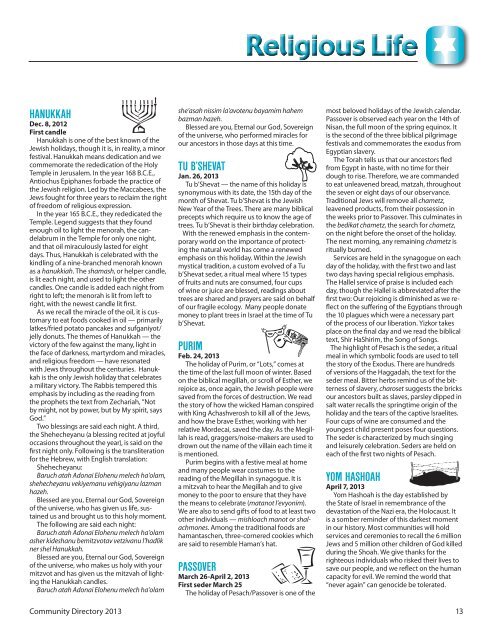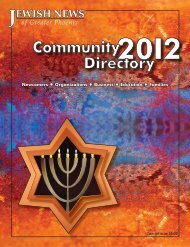downloadable PDF - Jewish News of Greater Phoenix
downloadable PDF - Jewish News of Greater Phoenix
downloadable PDF - Jewish News of Greater Phoenix
You also want an ePaper? Increase the reach of your titles
YUMPU automatically turns print PDFs into web optimized ePapers that Google loves.
HANUKKAH<br />
Dec. 8, 2012<br />
First candle<br />
Hanukkah is one <strong>of</strong> the best known <strong>of</strong> the<br />
<strong>Jewish</strong> holidays, though it is, in reality, a minor<br />
festival. Hanukkah means dedication and we<br />
commemorate the rededication <strong>of</strong> the Holy<br />
Temple in Jerusalem. In the year 168 B.C.E.,<br />
Antiochus Epiphanes forbade the practice <strong>of</strong><br />
the <strong>Jewish</strong> religion. Led by the Maccabees, the<br />
Jews fought for three years to reclaim the right<br />
<strong>of</strong> freedom <strong>of</strong> religious expression.<br />
In the year 165 B.C.E., they rededicated the<br />
Temple. Legend suggests that they found<br />
enough oil to light the menorah, the candelabrum<br />
in the Temple for only one night,<br />
and that oil miraculously lasted for eight<br />
days. Thus, Hanukkah is celebrated with the<br />
kindling <strong>of</strong> a nine-branched menorah known<br />
as a hanukkiah. The shamash, or helper candle,<br />
is lit each night, and used to light the other<br />
candles. One candle is added each night from<br />
right to left; the menorah is lit from left to<br />
right, with the newest candle lit first.<br />
As we recall the miracle <strong>of</strong> the oil, it is customary<br />
to eat foods cooked in oil — primarily<br />
latkes/fried potato pancakes and sufganiyot/<br />
jelly donuts. The themes <strong>of</strong> Hanukkah — the<br />
victory <strong>of</strong> the few against the many, light in<br />
the face <strong>of</strong> darkness, martyrdom and miracles,<br />
and religious freedom — have resonated<br />
with Jews throughout the centuries. Hanukkah<br />
is the only <strong>Jewish</strong> holiday that celebrates<br />
a military victory. The Rabbis tempered this<br />
emphasis by including as the reading from<br />
the prophets the text from Zechariah, “Not<br />
by might, not by power, but by My spirit, says<br />
God.”<br />
Two blessings are said each night. A third,<br />
the Shehecheyanu (a blessing recited at joyful<br />
occasions throughout the year), is said on the<br />
first night only. Following is the transliteration<br />
for the Hebrew, with English translation:<br />
Shehecheyanu:<br />
Baruch atah Adonai Elohenu melech ha’olam,<br />
shehecheyanu vekiyemanu vehigiyanu lazman<br />
hazeh.<br />
Blessed are you, Eternal our God, Sovereign<br />
<strong>of</strong> the universe, who has given us life, sustained<br />
us and brought us to this holy moment.<br />
The following are said each night:<br />
Baruch atah Adonai Elohenu melech ha’olam<br />
asher kideshanu bemitzvotav vetzivanu l’hadlik<br />
ner shel Hanukkah.<br />
Blessed are you, Eternal our God, Sovereign<br />
<strong>of</strong> the universe, who makes us holy with your<br />
mitzvot and has given us the mitzvah <strong>of</strong> lighting<br />
the Hanukkah candles.<br />
Baruch atah Adonai Elohenu melech ha’olam<br />
Religious Life<br />
she’asah nissim la’avotenu bayamim hahem<br />
bazman hazeh.<br />
Blessed are you, Eternal our God, Sovereign<br />
<strong>of</strong> the universe, who performed miracles for<br />
our ancestors in those days at this time.<br />
TU B’SHEVAT<br />
Jan. 26, 2013<br />
Tu b’Shevat — the name <strong>of</strong> this holiday is<br />
synonymous with its date, the 15th day <strong>of</strong> the<br />
month <strong>of</strong> Shevat. Tu b’Shevat is the <strong>Jewish</strong><br />
New Year <strong>of</strong> the Trees. There are many biblical<br />
precepts which require us to know the age <strong>of</strong><br />
trees. Tu b’Shevat is their birthday celebration.<br />
With the renewed emphasis in the contemporary<br />
world on the importance <strong>of</strong> protecting<br />
the natural world has come a renewed<br />
emphasis on this holiday. Within the <strong>Jewish</strong><br />
mystical tradition, a custom evolved <strong>of</strong> a Tu<br />
b’Shevat seder, a ritual meal where 15 types<br />
<strong>of</strong> fruits and nuts are consumed, four cups<br />
<strong>of</strong> wine or juice are blessed, readings about<br />
trees are shared and prayers are said on behalf<br />
<strong>of</strong> our fragile ecology. Many people donate<br />
money to plant trees in Israel at the time <strong>of</strong> Tu<br />
b’Shevat.<br />
PURIM<br />
Feb. 24, 2013<br />
The holiday <strong>of</strong> Purim, or “Lots,” comes at<br />
the time <strong>of</strong> the last full moon <strong>of</strong> winter. Based<br />
on the biblical megillah, or scroll <strong>of</strong> Esther, we<br />
rejoice as, once again, the <strong>Jewish</strong> people were<br />
saved from the forces <strong>of</strong> destruction. We read<br />
the story <strong>of</strong> how the wicked Haman conspired<br />
with King Achashverosh to kill all <strong>of</strong> the Jews,<br />
and how the brave Esther, working with her<br />
relative Mordecai, saved the day. As the Megillah<br />
is read, graggers/noise-makers are used to<br />
drown out the name <strong>of</strong> the villain each time it<br />
is mentioned.<br />
Purim begins with a festive meal at home<br />
and many people wear costumes to the<br />
reading <strong>of</strong> the Megillah in synagogue. It is<br />
a mitzvah to hear the Megillah and to give<br />
money to the poor to ensure that they have<br />
the means to celebrate (matanot l’evyonim).<br />
We are also to send gifts <strong>of</strong> food to at least two<br />
other individuals — mishloach manot or shalachmones.<br />
Among the traditional foods are<br />
hamantaschen, three-cornered cookies which<br />
are said to resemble Haman’s hat.<br />
PASSOVER<br />
March 26-April 2, 2013<br />
First seder March 25<br />
The holiday <strong>of</strong> Pesach/Passover is one <strong>of</strong> the<br />
ì<br />
most beloved holidays <strong>of</strong> the <strong>Jewish</strong> calendar.<br />
Passover is observed each year on the 14th <strong>of</strong><br />
Nisan, the full moon <strong>of</strong> the spring equinox. It<br />
is the second <strong>of</strong> the three biblical pilgrimage<br />
festivals and commemorates the exodus from<br />
Egyptian slavery.<br />
The Torah tells us that our ancestors fled<br />
from Egypt in haste, with no time for their<br />
dough to rise. Therefore, we are commanded<br />
to eat unleavened bread, matzah, throughout<br />
the seven or eight days <strong>of</strong> our observance.<br />
Traditional Jews will remove all chametz,<br />
leavened products, from their possession in<br />
the weeks prior to Passover. This culminates in<br />
the bedikat chametz, the search for chametz,<br />
on the night before the onset <strong>of</strong> the holiday.<br />
The next morning, any remaining chametz is<br />
ritually burned.<br />
Services are held in the synagogue on each<br />
day <strong>of</strong> the holiday, with the first two and last<br />
two days having special religious emphasis.<br />
The Hallel service <strong>of</strong> praise is included each<br />
day, though the Hallel is abbreviated after the<br />
first two: Our rejoicing is diminished as we reflect<br />
on the suffering <strong>of</strong> the Egyptians through<br />
the 10 plagues which were a necessary part<br />
<strong>of</strong> the process <strong>of</strong> our liberation. Yizkor takes<br />
place on the final day and we read the biblical<br />
text, Shir HaShirim, the Song <strong>of</strong> Songs.<br />
The highlight <strong>of</strong> Pesach is the seder, a ritual<br />
meal in which symbolic foods are used to tell<br />
the story <strong>of</strong> the Exodus. There are hundreds<br />
<strong>of</strong> versions <strong>of</strong> the Haggadah, the text for the<br />
seder meal. Bitter herbs remind us <strong>of</strong> the bitterness<br />
<strong>of</strong> slavery, charoset suggests the bricks<br />
our ancestors built as slaves, parsley dipped in<br />
salt water recalls the springtime origin <strong>of</strong> the<br />
holiday and the tears <strong>of</strong> the captive Israelites.<br />
Four cups <strong>of</strong> wine are consumed and the<br />
youngest child present poses four questions.<br />
The seder is characterized by much singing<br />
and leisurely celebration. Seders are held on<br />
each <strong>of</strong> the first two nights <strong>of</strong> Pesach.<br />
YOM HASHOAH<br />
April 7, 2013<br />
Yom Hashoah is the day established by<br />
the State <strong>of</strong> Israel in remembrance <strong>of</strong> the<br />
devastation <strong>of</strong> the Nazi era, the Holocaust. It<br />
is a somber reminder <strong>of</strong> this darkest moment<br />
in our history. Most communities will hold<br />
services and ceremonies to recall the 6 million<br />
Jews and 5 million other children <strong>of</strong> God killed<br />
during the Shoah. We give thanks for the<br />
righteous individuals who risked their lives to<br />
save our people, and we reflect on the human<br />
capacity for evil. We remind the world that<br />
“never again” can genocide be tolerated.<br />
Community Directory 2013 13



